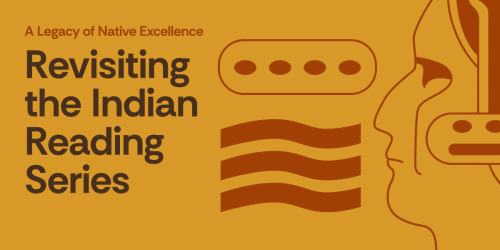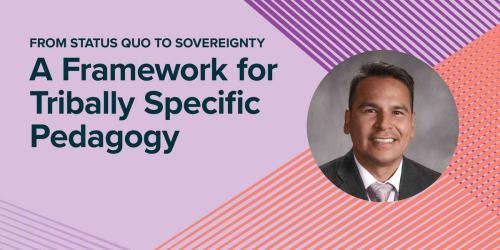Lessons from a Public Investment in Native Language Immersion Classrooms

For years, dedicated language keepers have sought to restore and revitalize Native languages in Montana. They have worked in communities across the state, often in schools, seeking to engage with young people who are hungry to learn more about their culture, identity and language.
Unfortunately, their monumental efforts have often been overlooked and sometimes curtailed—at many schools these teachers have been allotted minimal time for language instruction. As these experts are well aware, the work of language revitalization takes more than a few hours a week.
To address this limitation, State Senator Jonathan Windy Boy introduced Montana’s first-ever language immersion bill in 2015, the Cultural Integrity Commitment Act (Senate Bill 272). This legislation created a two-year window for using one-time-only state funds to initiate Native language immersion programs in public school classrooms. At the Montana Office of Public Instruction’s Indian Education Department, our role has been to provide information and to recruit and support schools interested in this opportunity.
Getting Started: Montana’s New Language Immersion Classrooms
In the first year of funding, Browning School District’s KW Bergen Elementary, located on the Blackfeet Reservation, was the only school to develop a Native language immersion program. To support Browning’s efforts, we reached out to the Northwest Comprehensive Center at Education Northwest, which put together a support team that focused on understanding the necessary structures and practices of successful immersion programs and providing professional development and ongoing assistance to educators at the schools.
Browning began its immersion program with a single, full-day kindergarten class in which half the day was taught in Blackfeet and the other half in English. The school paired a teacher with regular elementary school certification and a teacher with a Class 7 Native American language and culture certification. (In Montana, local tribes determine Class 7 certification eligibility for teachers who are experienced in language and culture and who may or may not have a regular teacher certification.)
In the second year of funding, Browning first-graders who participated in the program as kindergarteners had the same Class 7 language teacher, and the program was offered to another kindergarten class. In addition, two schools located on the Crow Reservation, Wyola Elementary and Crow Agency Elementary, received funding to develop Native language immersion programs.
This legislation presented an exciting opportunity to attempt immersion work in a public school setting and could be crucial to future Native language revitalization efforts. Here are some of the things we learned as a state education agency (SEA) about how to support Native language immersion programs.
Start by building relationships
As an SEA, it’s our responsibility to go above and beyond to make sure folks in schools and communities are well informed about opportunities and best practices. Working in Indian Country relies on creating the type of communication and relationships that are difficult to build through email, so taking the time to build trust and cultivate personal connections is essential. We needed to let people know that we can serve as a resource, and that if they were interested in this opportunity, we could help make it happen.
Understand how Native language immersion programs connect communities to schools and can impact student achievement
It’s important to remember that the schools that can benefit most from language immersion programs are often in communities that have struggled—and those struggles are reflected in student outcomes. Language immersion programs build school-community partnerships by creating a school environment that honors communities, cultures and values. That, in turn, can foster greater student belonging and resiliency—important factors in increasing student achievement.
Plan carefully and engage parents, families, and the community
When putting together a Native language immersion program, give yourself ample time to map out instruction and determine how to meet state standards. This planning time is also an ideal way to begin building the broad base of support you will need to be successful, including administrators, staff members, community experts, and others who care about the educational outcomes of Native students.
For example, when Jason Cummins, principal of Crow Agency School, realized that several groups had received language-preservation grants or were working on language-revitalization efforts but hadn’t come together as a community, he saw an opportunity. Working with a team, Cummins helped foster an environment in which people could come together to think about the big picture and share their knowledge and experience. In the process, he helped build a powerful resource for his school and students.
This type of community outreach does not end once an immersion program is in place. For example, in all three schools that have taken advantage of Senate Bill 272, there has been a concerted effort to engage the parents and families of participating children, such as offering evening language classes for adults or conducting activities that bring them into the classroom.
Long-term success depends on sustainability
SB 272 provided enough funding to support up to four Native language immersion programs for two years. Districts have stepped up to provide additional funding to get their classrooms up and running and maximize the opportunity. While state funding has ended, Browning, Wyola, Crow Agency, and other schools across the state are recognizing the value of these programs and are finding ways to support them locally.
Before SB 272, few thought it possible to implement a Native language immersion program in a public school—not on this level. Today, it’s a reality. One of the keys to sustaining the momentum for these programs will be to continue to grow interest by demonstrating that other schools have successfully met state standards and infused Native language immersion and revitalization throughout the regular school day.
I’ve seen how these efforts can and do foster pride and hope in our Native youth. Public investments in Native language immersion programs can help sustain and ensure future growth of one our state’s most precious resources—the cultures and languages of the first peoples.



